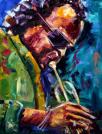Other Mixes By Feat Fan
CD
|
Mixed Genre
CD
|
Theme
CD
|
Mixed Genre
CD
|
Mixed Genre
CD
|
Mixed Genre


Stuff...Volume One
| Side A | ||
| Artist | Song | |
| Stuff | Miles In The Sky/1968 | |
| A Night In Tunisia | Musings of Miles/1955 | |
| Riot | Neferititi/1967 | |
| So What | Kinda Blue/1959 | |
| Sid's Ahead | Milestones/1958 | |
| New York City Girl | On The Corner/1972 | |
| recorded on Sunday | September 4, 2005 | |
| Side B | ||
| Artist | Song | Buy |
| On Green Dolphin Street | '58 Sessions/1958 | |
| Footprints | Miles Smiles/1966 | |
| Miles Runs The Voo Doo Down | Bitches Brew/1969 | |
| Water Babies | Water Babies/1976 | |
| Will O' Wisp | Sketches Of Spain/1960 | |
| Boplicity | Birth Of The Cool/1950 | |
| Old Folks | Someday My Prince Will Come/1961 | |
Comment:
Miles Davis (1926-1991) became an innovative force in musicduring the 1940s and remained so for nearly five decades.
Stuff "1"is a tribute to him...
It should be mentioned that Miles Davis is also considered a great artistic painter. In 1988 he created a series of abstract paintings. He was inspired by a Milan -based design movement known as "Memphis" founded by Ettore Sottsass. Known for "hot colors" and "clashing shapes" Memphis mixed and matched a variety of historical motifs and closely resembled a "postmodernism" style. Miles found this style appealing and created a large quantity of paintings. Most of the time Miles appeared on-stage in bright colored clothing that matched his painting style. He always seemed to dazzled his audiences with the color of sound that emanated from his horn and from his clothing. His paintings in New York City (1990) received enthusiastic reviews, as they did in Spain, West Germany and Japan.
Davis had a great artistic gift for painting and creating music. He is one of the very few jazz musicians of our time who had the ability to improvise and swing at a constant tempo. When Miles played a tune it became part of his soul and it never lost character. He passed away September 28, 1991 and he will be deeply missed. His music and influence in the world of jazz and art will remain with us for eternity.
Many of the great improvisers and their ideas within the Davis groups were nurtured through Miles Davis, as he acted as inspirational overseer. The music and styles of Miles Davis from one period of his life to the next varied quite differently. He has composed many tunes that today are considered standard repertoire for aspiring jazz musicians. Tunes such as Nardis, Milestones, and So What are typical examples. Miles Davis had an uncanny ability of always selecting great sidemen for his recording sessions. These recordings are full of original and creative sensitivity and are outstanding examples of jazz recordings made at that time.
His popularity was so great that he mistakenly received composer credit for a number of modern jazz standards such as Blue in Green (by Bill Evans) Tune Up and Four (by Eddie Vinson).
His creative and innovative approach to performing such great standards as Bye Bye Blackbird and On Green Dolphin Street has resulted in these tunes becoming great jazz standards. Considered one of the all time great melodic soloist of our time, Miles Davis can be characterized as having unusual and very skillful timing with simple or complex melodic phrases. As were his counter parts, Thelonious Monk Count Basie, Miles was a true master of restraint with regard to the creative process of his improvised lines.
His recording in 1954 of The Man I Love with Milt Jackson and Thelonious Monk and Bags Grove are typical examples of his inner ability of restraint with regard to phrasing and time. Other dramatic technique Miles used was his placement of notes and the use of silence during his solos. Known in the 1950s for his ability to vary the color of his sound, pitch, and the use of a Harmon mute, Miles solos resulted in a warm, rich, wispy, and even intimate improvisation. Examples are Seven Steps to Heaven and Kind of Blue, and today are part of every jazz musicians repertoire. Late in the 1960s Miles began to play more in the upper register.
Listen to Miles recordings in 1963 of Miles In Europe and Four and More (1964). In 1969 facing swirling social and musical currents, Miles incorporated the use of electronic instruments into his music. Using harsh dissonance's sounds from electronic instruments he changed the way music of the time was performed and understood. If you listen to his recordings in 1970 you notice his more explosive and violent style with long burst, shattered tones, electronic echoes, and numerous other alterations on his trumpet.
His lines are more varied and original than any other trumpeter of his time.
<b

Feedback:
good stuff
Which ever way you cut it, there's not much to top Miles - Cool!
Hey Scott, nice work. Just a suggestion, but why not start a new paragraph every once in a while by typing <p> where you want it to start.
I find Miles to be pretty personal - and by that I mean, I love him - in many forms, but not everybody appreciates genius. i could go for this (and I don't know everything here) - my wife would probably say she hated it, and then I would find it in her car in a couple of weeks time. Good job, but I wouldn't be surprised if you didn't get the cudos that this mix deserves.


